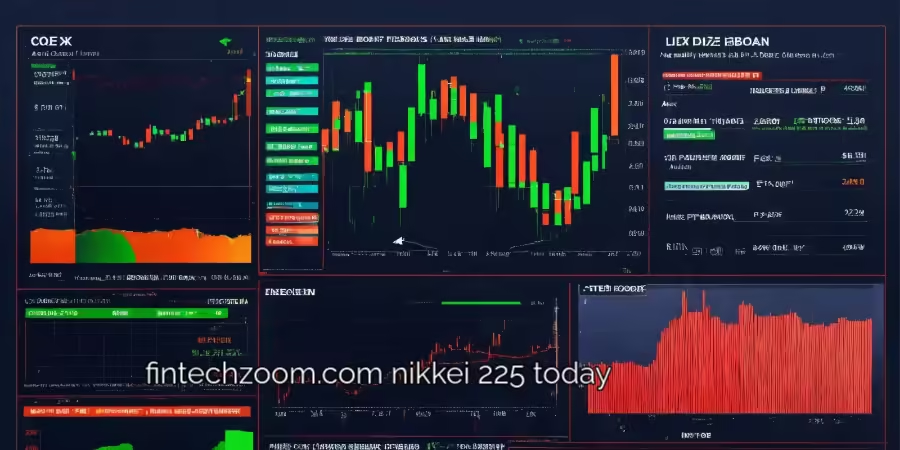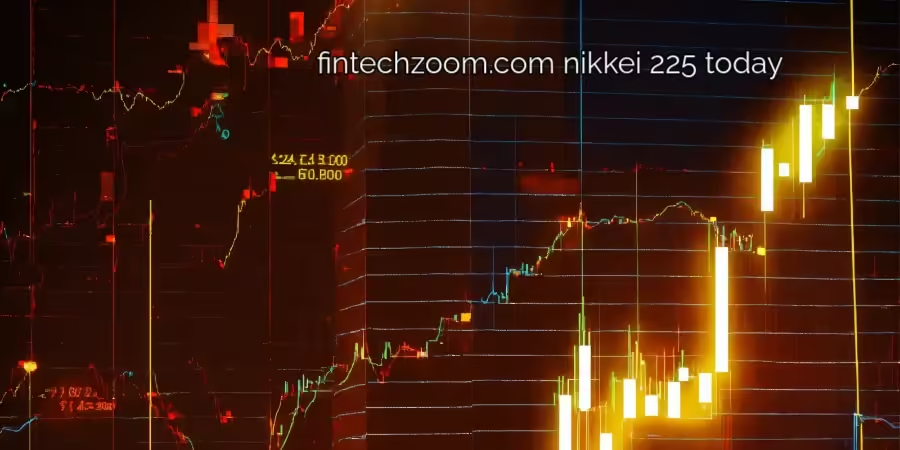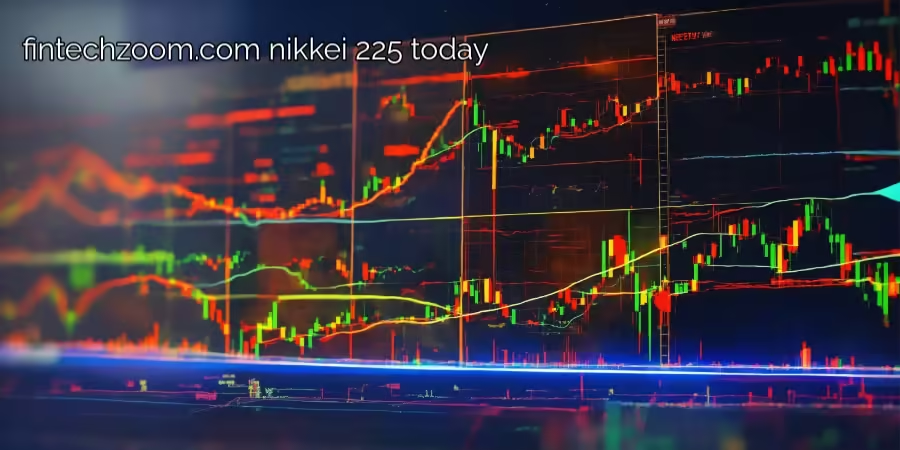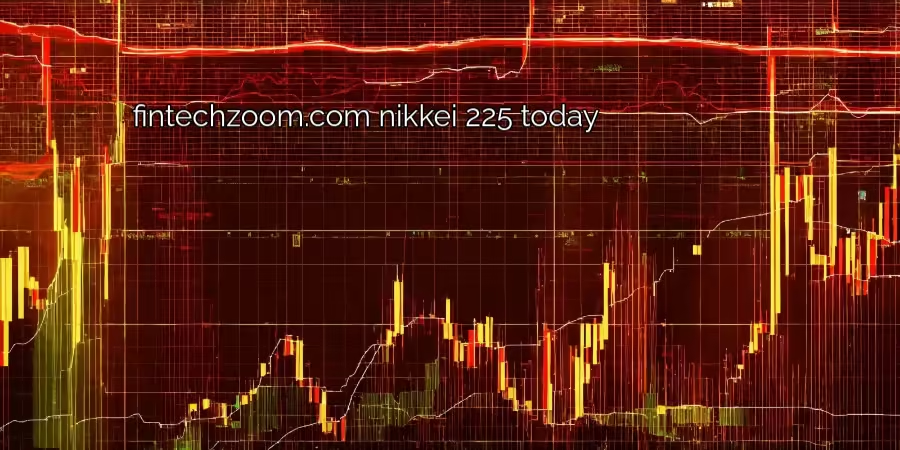introduction Fintechzoom.com Nikkei 225 Today
Fintechzoom.com Nikkei 225 Today is displaying blended overall performance, reflecting the continued fluctuations in international markets. On November 1, 2024, Japan’s stock marketplace closed decrease, with the Nikkei 225 slipping via 0.59%. Losses in key sectors inclusive of transportation device, rubber, and prescribed drugs weighed down the index Investing.Com UK. However, recent updates screen a few wonderful momentum in specific sectors, together with finance and banking Investing.Com UKIG.
The Impact of the Bank of Japan (BOJ) Monetary Policy at Fintechzoom.com Nikkei 225 Today
Fintechzoom.com Nikkei 225 Today: The Bank of Japan (BOJ)‘s financial coverage appreciably influences the Japanese financial system, and therefore, the performance of the Nikkei 225, Japan’s benchmark stock marketplace index. Comprised of 225 principal agencies throughout numerous sectors, the Nikkei 225 serves as a key barometer of Japan’s financial health. As such, selections made by the BOJ—on subjects like interest prices, quantitative easing (QE), and other economic techniques—play a pivotal position in shaping investor sentiment and, in turn, the overall performance of the Nikkei 225.

Table of Contents
1. Interest Rate Cuts: A Stimulus to Borrowing and Investment of Fintechzoom.com Nikkei 225 Today
Fintechzoom.com Nikkei 225 Today: One of the primary equipment the BOJ uses to steer economic pastime is the hobby fee. When the BOJ cuts hobby rates, borrowing will become inexpensive for both groups and customers. This commonly stimulates investment and spending, leading to better company income and, therefore, inventory prices. The growth in earnings regularly reflects undoubtedly at the Nikkei 225.
A large instance of this was in 2016, when the BOJ delivered poor interest charges. This unorthodox policy caused a temporary rally in inventory prices, as investors expected extended liquidity and decrease borrowing fees, which in turn spurred business investment and customer call for. While the effects of hobby price cuts may not continually be on the spot, they generally provide a quick-term raise to the market.
2. Quantitative Easing (QE): Injecting Liquidity Into the Market of Fintechzoom.com Nikkei 225 Today
Fintechzoom.com Nikkei 225 Today: Another critical coverage degree that the BOJ has hired through the years is Quantitative Easing (QE). QE refers back to the relevant financial institution purchasing large quantities of government bonds and other assets to growth the cash supply. This growth of liquidity facilitates make certain that credit score is available to companies and purchasers, fostering an surroundings of low interest charges.
The BOJ’s competitive asset-buying programs have traditionally had a positive effect on the Nikkei 225, as they growth the waft of capital into the stock market. Companies with smooth get admission to to financing can expand their operations, which reinforces investor self assurance. However, the high quality results of QE can be transient, and the lengthy-time period advantages regularly rely on broader worldwide monetary situations.

three. Inflation Targets and Economic Stimulus Fintechzoom.com Nikkei 225 Today
Fintechzoom.com Nikkei 225 Today: The BOJ’s inflation target is ready at round 2%. In a perfect global, this degree of inflation would replicate a growing economic system, as it shows an growth in demand. However, Japan has faced prolonged durations of low inflation or even deflation, and the BOJ has needed to step in to stimulate call for.
When inflation is beneath goal, the BOJ may additionally put into effect extra stimulus measures to reinforce the economic system. This may want to mean more price cuts, extended QE, or different kinds of economic support. Such movements tend to increase stock marketplace performance as buyers count on a choose-up in monetary pastime and company profits. Conversely, if inflation starts to rise too quickly, the BOJ may tighten its financial coverage—elevating hobby quotes or scaling lower back asset purchases—leading to decrease stock costs and a greater cautious investor outlook.
4. Yen Depreciation and Export-Driven Companies of Fintechzoom.com Nikkei 225 Today
Fintechzoom.com Nikkei 225 Today: One of the most enormous consequences of the BOJ’s financial coverage is its effect at the yen. When the BOJ cuts hobby fees or introduces QE, the price of the yen usually weakens. A weaker yen is specially useful for Japan’s export-driven businesses—consisting of Toyota, Sony, and Mitsubishi—which shape a tremendous portion of the Nikkei 225. These agencies advantage from a weaker forex because their items end up cheaper and more competitive in international markets.
For example, a 10% depreciation within the yen can enhance the profits of Japan’s most important exporters. This regularly results in elevated inventory costs of these companies, pushing the overall Nikkei 225 better. Given that exporters constitute a huge phase of the Nikkei 225, the yen’s movement is regularly intently watched by buyers.
5. Recent Trends and Effects in 2024
In latest years, the BOJ has maintained a low-hobby-rate policy, with costs hovering round zero or maybe beneath, to stimulate the slow economy. The BOJ has also persevered its QE measures, purchasing government bonds to inject liquidity into the economy. These policies have provided consistent guide for the Nikkei 225.
However, 2024 gives a extra complicated image. With worldwide financial elements entering play—including U.S. Hobby price hikes and financial slowdowns in China—investors have grow to be extra careful. The BOJ’s economic policies are dealing with headwinds from external monetary factors, and the consequences of such regulations can be less mentioned compared to preceding years.
Moreover, Japan’s home financial conditions—such as its ageing population and sluggish client call for—hold to weigh on economic boom, notwithstanding efforts from the BOJ to stimulate inflation and boom.
1. What is the Nikkei 225 and why is it critical?
The Nikkei 225 is Japan’s most beneficial inventory marketplace index, comprising 225 of the most important publicly traded corporations in Japan. It serves as a barometer for the general health of Japan’s stock marketplace and is broadly watched through traders and analysts round the sector. The Nikkei 225 is taken into consideration a reflection of Japan’s economic system, and its overall performance is crucial for traders who need to apprehend the wider market tendencies in Asia and international monetary shifts.
The index covers a extensive range of sectors, consisting of generation, automobile, banking, and consumer goods, making it a key indicator for Japan’s financial activity. For traders, it offers a precious picture of the marketplace’s general overall performance and sentiment, mainly in terms of international activities and monetary guidelines.
2. How can I music the real-time performance of the Nikkei 225?
Tracking the actual-time overall performance of the Nikkei 225 is quite easy with the help of financial news websites and market systems. Several on line assets offer stay updates, along with Fintechzoom.Com, Bloomberg, and Reuters, which offer the state-of-the-art statistics and analysis on the index. Additionally, many brokerage systems and monetary apps offer real-time updates at the Nikkei 225, with functions that allow traders to monitor marketplace moves, view charts, and receive notifications on essential shifts.
You can also get entry to stay stock prices, historical records, and the current performance of the index on predominant monetary systems which include Yahoo Finance and MarketWatch. These equipment frequently permit investors to personalize the records primarily based on special time durations (e.G., intraday, every day, month-to-month).

three. What are the pinnacle sectors affecting the Nikkei 225 nowadays?
The Nikkei 225 reflects diverse sectors of the Japanese economy, with certain sectors playing a greater influential position at specific times. Key sectors encompass:
- Technology and Electronics: Japan is home to global giants like Sony, Panasonic, and SoftBank, making this sector one of the number one drivers of the Nikkei 225.
- Automotive: Major automobile manufacturers like Toyota, Honda, and Nissan appreciably affect the index, specifically in times of monetary or geopolitical uncertainty.
- Banking and Financials: Banks and economic institutions additionally make up a considerable part of the index, and hobby fees set by the Bank of Japan (BOJ) can closely impact their performance.
- Consumer Goods and Retail: With Japan’s large and growing customer market, organizations in this sector, including Fast Retailing (Uniqlo), regularly have a prime effect on the index.
Understanding sectoral performance helps traders pick out which industries are leading or lagging in the Nikkei 225 at any given time.
four. How does the Nikkei 225 evaluate with other global inventory indices?
The Nikkei 225 differs from other prominent international stock indices like the S&P 500 (U.S.), the FTSE a hundred (U.K.), and the DAX (Germany) in phrases of composition and marketplace dynamics. While indices just like the S&P 500 are weighted via market capitalization, the Nikkei 225 is a rate-weighted index, meaning that higher-priced stocks have extra have an impact on on its movement.
Another key distinction is that the Nikkei 225 in general represents Japanese agencies and is for this reason more encouraged through home elements like the Bank of Japan’s regulations, yen fluctuations, and Japan’s economic performance. In evaluation, international indices are motivated by way of broader international marketplace tendencies.
The Nikkei 225’s performance frequently movements in tandem with global developments but also can be greater volatile because of Japan’s specific financial demanding situations, which include an getting older populace and deflationary pressures.
5. What are the quality funding techniques for investing in the Nikkei 225?
Investing in the Nikkei 225 requires cautious attention of the macroeconomic factors affecting Japan, along with interest costs, currency fluctuations, and international alternate relationships. A few strategies include:
- Exchange-Traded Funds (ETFs): ETFs tracking the Nikkei 225, consisting of the iShares Nikkei 225 ETF (NKY), allow traders to gain varied publicity to the index.
- Blue-Chip Stocks: Investing in foremost groups in the Nikkei 225, like Toyota, Sony, and Mitsubishi, affords exposure to pinnacle-appearing sectors.
- Sector-Specific Focus: Focus on unique sectors which include generation or automotive, which have traditionally shown sturdy boom within the Nikkei 225.
- Long-Term Holding: For buyers searching out sustained boom, taking an extended-time period function in Japan’s leading corporations should enjoy the u . S .’s sturdy production and export base.
Diversifying throughout sectors inside the Nikkei 225 can help mitigate risks even as positioning for long-term growth.

6. How does forex fluctuation effect the Nikkei 225?
The yen’s fee performs a vital role inside the overall performance of the Nikkei 225. As Japan’s export-oriented financial system relies upon heavily on international change, the value of the yen without delay influences the competitiveness of Japanese exports.
- Weaker Yen: When the yen weakens towards different currencies just like the U.S. Dollar, Japanese organizations can rate their merchandise more competitively overseas, which regularly boosts their earnings. This is commonly fine for the Nikkei 225 because it allows boom the stock prices of exporters like Toyota and Sony.
- Stronger Yen: A stronger yen could make Japanese goods more highly-priced in international markets, doubtlessly harming the profitability of export-driven businesses and leading to a decline in inventory charges, negatively affecting the Nikkei 225.
Investors intently monitor currency fluctuations as they are able to have an outsized effect at the index, in particular given Japan’s reliance on exports.
7. What are the risks involved in investing in the Nikkei 225?
Like any fairness market, investing within the Nikkei 225 carries positive risks, along with:
- Market Volatility: The Nikkei 225 can revel in giant fluctuations because of monetary, geopolitical, or company-particular activities.
- Currency Risk: The cost of the yen can effect the stock expenses of major exporters, introducing volatility for foreign investors.
- Global Economic Conditions: Japan’s export-heavy financial system makes it liable to economic slowdowns in main buying and selling companions, especially China and the U.S.
- Policy Risks: Changes within the Bank of Japan’s economic policy or shifts in political management can create uncertainties within the market.
As with any funding, information the underlying dangers and growing a diverse portfolio can assist mitigate a number of these ability downsides.
8. How do income reviews have an effect on the Nikkei 225’s movements?
Earnings reports are a key driver of the Nikkei 225’s moves. Strong income reviews generally cause fine inventory price movements, in particular for principal organizations along with Toyota, Sony, and SoftBank. The market’s reaction to these reviews is stimulated through several elements:
- Revenue Growth: Companies exceeding revenue expectancies often see their inventory costs upward push, which could push the whole Nikkei 225 higher.
- Profit Margins: Investors be aware of earnings margins and the employer’s ability to manage charges efficiently.
- Guidance for Future Growth: Positive steerage or strong ahead-looking statements by organisation executives often lead to constructive marketplace sentiment.
- Sector Impact: Strong income in key sectors, which includes technology or car, will have a larger impact on the Nikkei 225 due to the load of those sectors within the index.
Overall, earnings reviews give investors an perception into the health of groups within the Nikkei 225, shaping brief-term and lengthy-time period marketplace sentiment.
Conclusion: Staying Informed and Investing within the Nikkei 225
Recap of Key Takeaways for Investors Tracking the Nikkei 225 Today
In nowadays’s rapid-paced economic panorama, staying knowledgeable about the contemporary market actions, mainly those influencing key inventory indices just like the Nikkei 225, is crucial for investors. The Nikkei 225, as Japan’s main stock index, gives precious insights into the performance of principal Japanese businesses and the health of Japan’s economic system. By tracking its daily overall performance, traders can better apprehend shifts in investor sentiment, sectoral overall performance, and broader financial situations.
Key takeaways for traders consist of:
- The importance of real-time facts in understanding the Nikkei 225’s fluctuations, which might be pushed by using global monetary factors and nearby tendencies.
- How the Bank of Japan’s economic policy impacts investor conduct, impacting hobby charges, inflation objectives, and yen depreciation.
- The function of currency fluctuations, in particular the yen’s energy or weak point, in shaping the overall performance of export-pushed sectors like automotive and generation.
- The sector-particular traits affecting fundamental players within the Nikkei 225, from generation and electronics to purchaser goods and financials.






